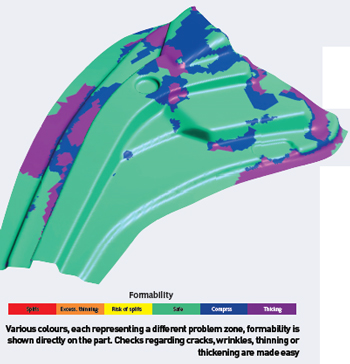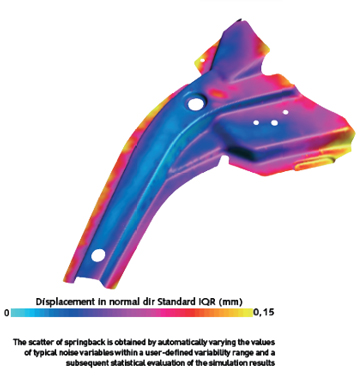By using the correct simulation software prior to the whole stamping process being carried out, OEMs can make cost savings by reducing engineering, manufacturing and tryout time, thus remaining competitive in a saturated global market
A few decades ago, customers had a choice of limousines, coupés, sports cars and convertibles. Nowadays there are more segments: SUVs, MPVs, microcars, four-door coupés and as shown at this year’s IAA Motor Show in Frankfurt, the first sport activity vehicle (SAV). OEMs strive to occupy every niche to gain market share in a stagnating worldwide vehicle market. The rise of subsegmenting has seen production numbers decreasing for individual models. However, whether a low- or high volume model, development costs tend to remain similar, thus OEMs need to reduce costs in other areas. One way is to use a single platform for different models or brands for bodies in- white, thus spreading the investment, but still retaining enough product separation.
Another approach is flexible vehicle architecture. However, skin panels of different models always vary in shape despite a similar platform. Only when you get under the ‘skin’ of the vehicle is it evident that parts are consistent between various models. Whichever path OEMs choose to take to reduce costs, they also have to meet the growing pressure of shorter deadlines in getting products to market, and responding quicker to a fickle buying public and ever-changing markets.
 The challenges of BIW manufacturing
The challenges of BIW manufacturing
Major investment is needed for tooling, materials manufacturing and press lines prior to the first body-inwhite coming off the line, therefore potential cost savings lie in reduced engineering, manufacturing and tryout time.
Moreover, time to market for bodies-in-white is mainly determined by dies. Any reduction in lead-time is beneficial. Because of the rising cost of materials, any improvement in usage directly affects the total costs, and results in less scrap.
What is essential is that there are fewer downtimes of the press lines and that production runs as smoothly as possible.
Achieving reductions in time, material consumption and costs are not the only challenges that OEMs face. New materials and production technologies such as hot-formed parts or tailor-welded blanks from a few years ago require a constant brush-up of existing knowledge (an added expense). This can be achieved by carrying out more testing and tryouts, but this contradicts the notion of potential savings. What course of action should be taken to achieve these reductions and increase knowledge of new materials in terms of die design and sheet metal forming? The answer is simulation. Before any die is machined in reality and swarf drops, die and tools and the whole stamping process is done virtually, using suitable software.
Simulation is your way to get it right, every time
A simulation allows the user to quickly see how the tool layout is working and to decide how many stamping stages or different tool sets are necessary for the whole process.
If there is uncertainty, the user can simply do another simulation with the new settings or different operations included, provided the processes can be set up easily in the simulation software and calculation time is not excessive.
Despite extensive data handling during simulation, the software needs to calculate input as quickly as possible, and for maximum benefit, it should be easy and intuitive to use. This reduces the necessary specialist knowledge required for using the software. Although calculation time is a key factor when simulating, it should not be achieved at the expense of accuracy.
To ensure quality parts within the required specifications, high accuracy is non-negotiable. Additionally springback counteracts part quality, so this phenomenon must be taken in to account constantly. Because there are varying process parameters that are not 100% controllable, relying on only one simulation is not enough. It is essential to do several simulations and to evaluate them. Only this will give an idea of how the proposed process reacts to the changing parameters. The goal of the simulation is a robust process that assures the reliable production of quality parts.
Before production can start, tooling is needed. Based on simulation results, specialised software helps prepare these for manufacture. Therefore, compatibility with CAD software is imperative, especially with CATIA V and Unigraphics, the two most widely used CAD packages. Like this, a comprehensive digital workflow is possible which obviously helps maximise productivity and minimise sources of error.
 A closer look at springback and compensation
A closer look at springback and compensation
Springback nearly always occurs in a stamped part. To guarantee an accurate simulation of springback, it must be possible to set up the entire stamping process, especially in a multiple stage pressing setup. Only then are the relevant factors available to run through all operations of a press line. Springback gained importance because of the use of high-strength steels, aluminium and tailored blanks, which have set the trend for car bodies.
The reason is that safety regulations are getting stricter and discussions about the environment and CO2 emissions keep the pressure on OEMs to further reduce car body weights. Die and toolmakers’ knowhow, developed over a number of years, reaches its limit when it comes to these new materials and production technologies.
The formability is difficult, strain hardening higher, stiffness of aluminium lower, and elastic springback therefore significantly higher. Meeting the dimensional specifications creates difficulties while demand for even better quality persists, depicted in better fit and smaller clearance.
Simulation requires a finite element formulation that predicts strain states. Simulating springback also needs stress states, which increases complexity. The main challenge remains compensating die faces based on simulation results already achieved during the tool development phase. The aim is improved quality before the real tryout begins, thus minimising this time consuming and costly phase.
Simulations need to be all encompassing
Implementing springback compensation requires that some preconditions are fulfilled. Secondary operations like trimming or flanging need to be included in the simulation as these have an impact on springback.
 The simulation result after deep-drawing and, for example after flanging, is not necessarily the same. Springback is a complex affair and its reliable compensation only makes sense when the entire forming process is robust.
The simulation result after deep-drawing and, for example after flanging, is not necessarily the same. Springback is a complex affair and its reliable compensation only makes sense when the entire forming process is robust.
Experience shows that friction, blankholder force, blank position and material properties vary during manufacturing and interfere in the processes. Automatically varying these variables within a user-defined variability range and running multiple simulations shows the behaviour in the real manufacturing environment. Subsequent statistical evaluations help to explain how the areas with large springback variations can be positively influenced.
To get the full advantage of springback simulation in such an early phase and of the digital workflow as a whole, the compensated and validated die face data have to be transferred to CAD/CAM systems through appropriate interfaces. This allows generating milled surfaces and ultimately milling data without any delay.
Software helps OEMs yield cost savings
In the latest version of AutoForm’s software solution for the die-making and sheet metal forming industries, springback and the compensation of it are included. All vehicle makers use it, as do hundreds of press tool and stamping suppliers in the automotive industry. AutoForm’s solutions for feasibility, planning, tooling, tryout and production robustness are able to yield cost savings for tooling, material, press lines, and scrap, among others. Running stamping simulations in hours rather than days allows the engineer to quickly try alternative concepts. This allows him to be creative to find the optimum solution without disrupting the schedule.
Simulation results in savings during tryout and robust production, not to mention having part quality from the start. Additional increase of throughput and productivity can be expected too.
.jpg)


































